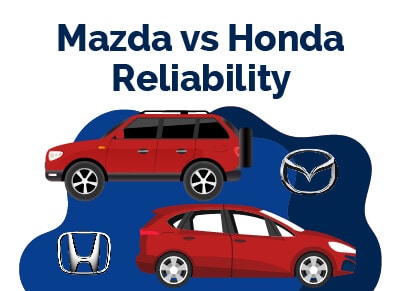Mazda vs Honda: Which Is More Reliable?
January 3, 2024


I am a serial entrepreneur and a consumer advocate. When I’m not helping car buyers, I love working on ventures that have a positive impact.
I run a cause marketing agency and serve on the board of Vayu Global Health where we are disrupting the medical industry and preventing the needless deaths of mothers and babies during childbirth.
Mazda cars offer low maintenance costs and few problems, similar to Honda, while also boasting enhanced safety and passenger protection features.
However, in terms of reliability, Honda is considered superior to Mazda.
Mazda cars are known for their enviable reliability, enjoyable driving experience, serious approach to safety, and affordability. Meanwhile, Honda slightly outperforms Mazda in reliability, with higher safety ratings, lower maintenance costs, and greater dependability.
Mazda is quickly enhancing its reputation for reliability, yet it still has progress to make to surpass Honda.
Table of Contents
Mazda vs. Honda Reliability: A Detailed Comparison
| Features | Mazda | Honda |
| Design | ||
| Repair and Maintenance Cost | ||
| Durability | ||
| Engine | ||
| Gas Mileage | ||
| Safety and Technology |
Which Is More Reliable? Honda or Mazda?
Honda surpasses Mazda in reliability.
While Mazda excels in safety and performance, Honda's models often provide better fuel efficiency.
Mazda offers superior handling and steering response, encouraging drivers to explore their limits safely.
Returning to reliability, Honda scores higher than Mazda. According to Repairpal, Honda has a reliability rating of 4.0/5.0, ranking 1st out of 32 car brands, while Mazda ranks 5th, with a reliability of 4.0/5.0.
Mazda Vs. Honda Reliability: Design
Honda and Mazda do not directly compete in their design philosophies. Both brands have unique design philosophies that cater to different target audiences.
Mazda emphasizes the fun-to-drive aspect, while Honda focuses on functionality and human-centered design.
In 2021, Honda introduced a new design philosophy focused on 'Simplicity and functionality.' Honda has always led in user-friendly designs, being the first to adopt the 'one-key' approach for doors, ignition, and all other locks. Honda is advancing its design philosophy, evolving from simple, spacious cars to vehicles that evoke positive emotions, a standard Mazda also upholds.
Mazda's designs are characterized by elegance, beauty, and simplicity, aiming to create a realistic and lifelike connection between drivers and their cars.
Both Honda and Mazda have faced customer complaints regarding paint peeling. The main difference lies in their appeal to distinct customer preferences.
Winner: Tie
Mazda Vs. Honda Reliability: Repair and Maintenance Cost
It is cheaper to repair/maintain a Honda than a Mazda. The average annual cost of repairing/maintaining a Honda is $428, whereas Mazda costs $462. This includes the fact that Mazda comes with a 0.4 chance of minor repairs and a 10% chance of major repairs.
Although Honda has a slight advantage over Mazda with a 0.3 chance of minor repairs and the same 10% probability for major repairs, both car brands have a repair/maintenance cost that is cheaper than the average $652 for all car models.
Winner: Honda
Mazda Vs. Honda Reliability: Durability
Mazdas are known for durability, yet Hondas surpass them in reliability and performance. The Mazda brand doesn't enjoy a reputation as strong as Honda's. Hondas are widely recognized for their affordable and efficient systems.
The quality of Honda's interiors, exteriors, and steel strength immediately conveys their cars' durability. Mazda, a Japanese car brand, employs traditional design principles like Takumi (craftsmanship), Kodo (soul of motion), and Takuminuri (paint technology), emphasizing quality and aesthetics.
Both Honda and Mazda offer identical warranty coverage, reflecting their confidence in vehicle reliability: a five-year/60,000-mile powertrain warranty.
Winner: Honda
Mazda Vs. Honda Reliability: Engine and Performance
The key differences between Mazda and Honda cars are their focus areas: Mazda prioritizes performance, while Honda emphasizes reliability and comfort for everyday driving.
Choose Mazda for racing-inspired performance, while Honda offers engines that are robust and versatile for all driving needs.
Mazda's continued use of rotary engines has sparked debate due to concerns over fuel economy and reliability. Despite its impressive handling and lightweight frame, Mazda often receives complaints about poor fuel economy and engine durability. These issues have significantly impacted Mazda's reliability ratings.
Although Mazda has improved its engines, choosing between Mazda and Honda depends on your preference for performance or longevity.
Winner: Tie
Mazda Vs. Honda Reliability: Gas Mileage
On average, Honda cars achieve higher gas mileage than Mazda cars.
SkyActiv technology by Mazda significantly improves fuel efficiency, making cars more economical by optimizing fuel use.
Honda's Eco button and assist system help drivers save fuel and maintain performance efficiently.
Although both brands offer innovative technologies, Honda cars generally outperform Mazda in fuel economy. For example, the Honda Civic achieves better fuel economy than the Mazda 3.
Winner: Honda
Mazda Vs. Honda Reliability: Safety and Technology
Choosing either Honda or Mazda ensures a high level of safety. Mazda and Honda are closely matched in safety ratings.
Mazda boasts superior safety technology, yet Honda has a greater number of models with higher safety ratings.
In 2021, Mazda had seven cars with top ratings, compared to Honda's eight. Mazda's cars are generally safer than Honda's when comparing safety ratings.
Mazda's Mazda 3 sedan and CX5, its safest cars, each have a safety rating of 9.9/10.
Overall, Mazda's safety rating is 9.8/10, compared to Honda's 9.53.
Winner: Tie
Verdict: Which One Is More Reliable?
Honda led in three ranking metrics and tied in three others.
Honda and Mazda are both reliable, but Honda is slightly more.
Consider your needs: Hondas are more reliable and safer, while Mazdas offer a more exhilarating driving experience.
Best Car Deals by Category
Frequently Asked Questions
Is Mazda expensive to maintain?
No. Mazda is not expensive to maintain. The average annual cost of maintenance on a Mazda is $462, which is cheaper than the $652 cost across all models.
Why are Honda engines the best?
Honda engines are built to last and stand the test of time. They are built with high-quality components which deliver optimum performance even in the worst terrains or environments. Not only are their engines durable, but they also have high power output.
Posted in Car Buying Tips, Car Troubleshooting |




